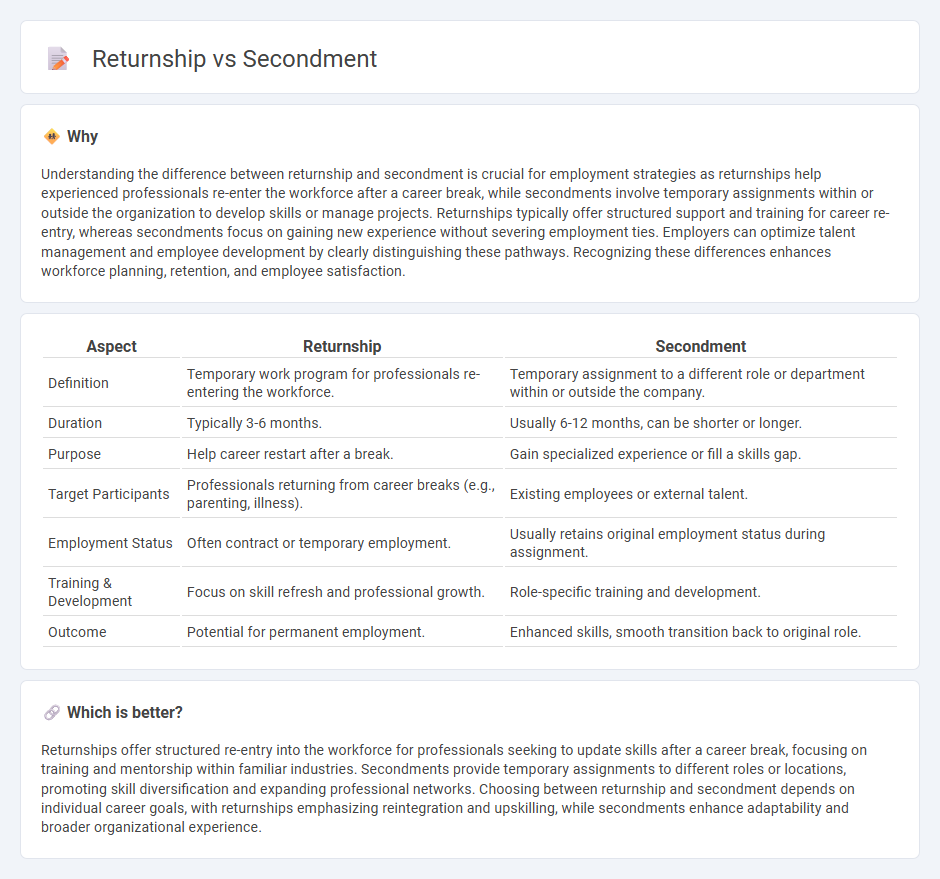
Returnships offer professionals a structured pathway back into the workforce, focusing on skill refreshment and career reintegration after a career break. Secondments provide employees with temporary assignments in different departments or organizations to gain new experiences and enhance professional development. Discover more about how returnships and secondments can accelerate career growth and organizational success.
Why it is important
Understanding the difference between returnship and secondment is crucial for employment strategies as returnships help experienced professionals re-enter the workforce after a career break, while secondments involve temporary assignments within or outside the organization to develop skills or manage projects. Returnships typically offer structured support and training for career re-entry, whereas secondments focus on gaining new experience without severing employment ties. Employers can optimize talent management and employee development by clearly distinguishing these pathways. Recognizing these differences enhances workforce planning, retention, and employee satisfaction.
Comparison Table
| Aspect | Returnship | Secondment |
|---|---|---|
| Definition | Temporary work program for professionals re-entering the workforce. | Temporary assignment to a different role or department within or outside the company. |
| Duration | Typically 3-6 months. | Usually 6-12 months, can be shorter or longer. |
| Purpose | Help career restart after a break. | Gain specialized experience or fill a skills gap. |
| Target Participants | Professionals returning from career breaks (e.g., parenting, illness). | Existing employees or external talent. |
| Employment Status | Often contract or temporary employment. | Usually retains original employment status during assignment. |
| Training & Development | Focus on skill refresh and professional growth. | Role-specific training and development. |
| Outcome | Potential for permanent employment. | Enhanced skills, smooth transition back to original role. |
Which is better?
Returnships offer structured re-entry into the workforce for professionals seeking to update skills after a career break, focusing on training and mentorship within familiar industries. Secondments provide temporary assignments to different roles or locations, promoting skill diversification and expanding professional networks. Choosing between returnship and secondment depends on individual career goals, with returnships emphasizing reintegration and upskilling, while secondments enhance adaptability and broader organizational experience.
Connection
Returnship programs and secondments both facilitate employment transitions by offering professionals opportunities to re-enter the workforce or gain new experience within a different role or department. Returnships provide structured, temporary placements tailored for individuals returning after career breaks, while secondments temporarily assign employees to different teams or organizations to develop skills and broaden expertise. Both strategies enhance talent retention, skill diversification, and career progression in dynamic employment landscapes.
Key Terms
Temporary Placement (Secondment)
Secondment refers to the temporary placement of an employee within a different department or organization, often lasting from a few months to a year, aimed at skill development and knowledge transfer. Returnships, on the other hand, are structured programs designed to reintegrate professionals, typically after a career break, into the workforce with mentorship and training. Explore more about the strategic benefits of secondments and how they differ from returnships in workforce development.
Career Re-entry (Returnship)
Career re-entry through returnships offers structured, temporary programs designed specifically for professionals re-entering the workforce after a career break, often featuring mentorship and skill refreshment opportunities. Secondments typically involve temporary assignments within the same organization or to partner companies, primarily aimed at skill development or project support rather than reintegration after a hiatus. Explore how returnships can uniquely support your career comeback and professional growth.
Skill Development
Secondments provide employees with temporary assignments in different roles or departments, enhancing skill development through hands-on experience and exposure to new challenges. Returnships are structured programs designed for professionals re-entering the workforce after a career break, focusing on updating skills, networking, and rebuilding confidence. Explore detailed comparisons to understand which option best supports your career growth and skill enhancement.
Source and External Links
What is a Secondment? | HR & Payroll Glossary - Secondment is a temporary work arrangement where an employee is reassigned to a different role within their organization or with an external partner.
What Is Secondment? Meaning + Examples - A secondment involves assigning an employee to work temporarily for a different organization while maintaining employment with their original employer.
Secondment - Wikipedia - Secondment is the temporary assignment of a member of one organization to another organization, where the employee retains their salary and employment rights from the original organization.
 dowidth.com
dowidth.com